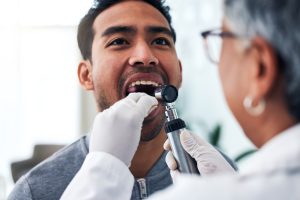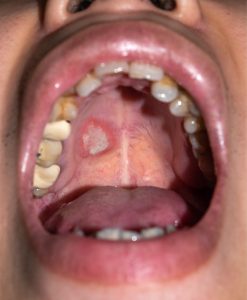Early Detection Saves Lives – Comprehensive Oral Cancer Screening at Pristine Dental
Every year, over 54,000 Americans receive oral and oropharyngeal cancer diagnoses, yet many cases remain undetected until reaching advanced stages when treatment becomes more complex and outcomes less favorable. At Pristine Dental in Scottsdale, Dr. Stephanie Smith and Dr. Keith Cooper believe in the life-saving power of preventive screening to identify oral cancer early.
Our experienced Scottsdale dental team incorporates thorough oral cancer examinations into every routine visit, providing patients throughout Paradise Valley, Fountain Hills, and Phoenix with comprehensive screening that could save your life. Don’t delay this critical health assessment—schedule your oral cancer screening today by calling (480) 935-2424.
Why Choose Pristine Dental for Oral Cancer Screenings
Advanced Diagnostic Excellence in the Heart of Scottsdale
At Pristine Dental, our commitment to comprehensive oral health extends beyond routine dental care to include life-saving cancer detection services. Dr. Smith’s specialized training in orofacial pathology and Dr. Cooper’s extensive experience as a board-certified prosthodontist provide patients with diagnostic expertise that goes far beyond standard dental examinations.
Our state-of-the-art facility on East Thomas Road features the latest diagnostic technology, including advanced imaging systems and specialized screening equipment that enhance our ability to detect suspicious lesions in their earliest stages. This technology, combined with our doctors’ clinical expertise, provides patients with the most thorough oral cancer screening available in the Scottsdale area.
We understand that cancer screenings can cause anxiety, which is why our compassionate team creates a supportive environment where patients feel informed and comfortable throughout the process. Our patient-centered approach includes clear communication about findings and immediate coordination with specialists when further evaluation is needed.
What Are Oral Cancer Screenings?
 Oral cancer screening is a systematic examination performed by qualified dental professionals to identify malignant or pre-malignant lesions within the oral cavity and surrounding tissues before they progress to life-threatening stages. Unlike other cancers that may require specialized testing facilities, oral cancer screenings can be seamlessly integrated into routine dental examinations, making this life-saving prevention both convenient and accessible.
Oral cancer screening is a systematic examination performed by qualified dental professionals to identify malignant or pre-malignant lesions within the oral cavity and surrounding tissues before they progress to life-threatening stages. Unlike other cancers that may require specialized testing facilities, oral cancer screenings can be seamlessly integrated into routine dental examinations, making this life-saving prevention both convenient and accessible.
The American Cancer Society emphasizes that regular oral cancer screening serves as an early warning system that can detect abnormal tissue changes months or years before they become symptomatic. This early detection window represents the difference between highly treatable early-stage disease and advanced cancer that may require extensive treatment with uncertain outcomes.
Types of Oral Cancer Screening Methods
Modern oral cancer detection utilizes multiple screening approaches to maximize early detection success:
- Visual and Tactile Examination: Traditional screening method involving systematic inspection of all oral surfaces using proper lighting, magnification, and palpation techniques to detect lumps, color changes, or tissue irregularities.
- Enhanced Visualization Technology: Advanced screening devices that use special lighting wavelengths to highlight abnormal tissue metabolism, making suspicious areas more visible to trained practitioners.
- Toluidine Blue Staining: Specialized dye application that helps identify potentially malignant lesions by staining abnormal cells differently from healthy tissue, improving diagnostic accuracy.
- Brush Biopsy Techniques: Minimally invasive sampling methods that collect cellular material from suspicious areas for laboratory analysis without requiring surgical procedures.
- Digital Photography Documentation: Systematic photographic recording of oral tissues that allows for comparison over time and facilitates consultation with specialists when needed.
- Comprehensive Risk Assessment: Evaluation of patient history, lifestyle factors, and clinical findings to determine individual cancer risk and appropriate screening frequency.
Your Comprehensive Oral Cancer Screening Process
Our thorough screening protocol ensures no potentially dangerous areas are overlooked during routine dental exams:
- Medical History Review: Dr. Smith or Dr. Cooper evaluates your personal and family cancer history, tobacco use, alcohol consumption, HPV exposure, and other risk factors that influence the screening approach.
- Comprehensive Visual Inspection: Using advanced lighting and magnification, we systematically examine all oral surfaces, including areas often missed during routine care, such as the base of the tongue and throat.
- Tactile Tissue Assessment: Gentle palpation of oral tissues, neck lymph nodes, and facial structures to detect lumps, swelling, or abnormal tissue consistency that may indicate developing problems.
- Advanced Technology Application: When indicated, specialized screening devices, such as special oral cancer screening dyes and lights, enhance visualization of suspicious tissues through fluorescence or other advanced detection methods.
- Documentation and Analysis: Detailed recording of findings with photographic documentation when appropriate, creating baseline records for future comparison and specialist consultation.
- Risk Stratification: Assessment of individual risk factors to determine appropriate follow-up schedules and additional protective measures for high-risk patients.
- Results Communication: Clear explanation of findings, discussion of any concerns, and immediate referral coordination when further evaluation is needed.
- Follow-Up Planning: Establishment of appropriate screening schedules based on individual risk factors and clinical findings to maintain ongoing protection.
Who Should Receive Regular Oral Cancer Screenings?
While oral cancer can affect anyone, certain individuals face elevated risks requiring more frequent monitoring:
- Adult Patients Over 45: Age represents a significant risk factor, with oral cancer incidence increasing substantially after middle age, making regular screening essential for early detection.
- Tobacco Users: Smoking, chewing tobacco, and other tobacco products dramatically increase oral cancer risk, requiring more frequent professional monitoring and enhanced screening protocols.
- Heavy Alcohol Consumers: Regular alcohol consumption, particularly when combined with tobacco use, creates a synergistic cancer risk that demands vigilant professional surveillance.
- HPV-Positive Individuals: Human papillomavirus infection, particularly high-risk strains, significantly increases oropharyngeal cancer risk, necessitating specialized screening approaches.
- Sun Exposure History: Individuals with significant lifetime sun exposure, especially those with fair skin, face increased lip cancer risk, requiring careful monitoring of lip borders and surrounding tissues.
- Previous Cancer Survivors: Patients with personal histories of any cancer type face elevated risks for developing secondary oral cancers, making regular screening critically important.
During consultation, our doctors evaluate individual risk profiles to determine appropriate screening frequencies and protocols that provide optimal protection based on specific circumstances and medical history.
Life-Changing Benefits of Professional Oral Cancer Screening
Regular oral cancer screening at Pristine Dental provides numerous advantages that extend far beyond simple peace of mind:
- Enhanced Survival Outcomes: Early-stage oral cancer detection provides five-year survival rates exceeding 80%, compared to below 50% for advanced cases, representing the difference between a highly curable disease and a life-threatening illness.
- Preserved Quality of Life: Early intervention maintains normal speech, swallowing function, and facial aesthetics that extensive cancer treatments may compromise, protecting your ability to communicate and enjoy food throughout your life.
- Reduced Treatment Complexity: Catching cancer in its earliest stages often allows for conservative treatment approaches that avoid the need for chemotherapy, radiation, or reconstructive surgery that advanced cases require.
- Cost-Effective Healthcare: Early detection and treatment typically cost significantly less than managing late-stage oral cancer, protecting both your health and financial well-being from devastating medical expenses.
- Professional Expertise Advantage: Unlike self-examinations that miss subtle changes, professional screenings utilize specialized training, equipment, and techniques to identify suspicious areas invisible to untrained observation.
- Comprehensive Risk Management: Regular screening provides ongoing monitoring for high-risk patients, creating early warning systems that catch problems before they become life-threatening emergencies.
- Peace of Mind: Routine screening eliminates anxiety about undetected oral health problems while providing confidence that potential issues will be identified and addressed promptly.
- Family Protection: Early detection benefits extend to family members who may share genetic or environmental risk factors, providing protection for entire households through proactive screening programs.
Recognizing Early Warning Signs of Oral Cancer
Understanding oral cancer symptoms empowers patients to seek professional evaluation when concerning changes occur. Contact Pristine Dental immediately if you experience any of these persistent symptoms lasting more than two weeks:
 Visible Oral Changes
Visible Oral Changes
- Non-Healing Sores: Mouth ulcers or lesions that persist beyond normal healing timeframes may indicate developing malignancy requiring immediate professional assessment.
- Color Changes: White patches (leukoplakia), red patches (erythroplakia), or mixed red-and-white lesions represent potentially pre-malignant conditions needing expert evaluation.
- Texture Abnormalities: Rough, crusty, or eroded areas in the mouth that feel different from normal tissue may signal early cancer development.
- Unexplained Bleeding: Oral bleeding without trauma or apparent cause requires professional investigation to rule out malignant processes.
Functional Symptoms
- Swallowing Difficulties: Persistent pain or difficulty swallowing (dysphagia) may indicate throat or tongue cancer affecting normal function.
- Speech Changes: Voice alterations, chronic hoarseness, or changes in speech patterns can signal developing oral or throat malignancies.
- Jaw Dysfunction: Stiffness, limited mouth opening, or changes in bite alignment may indicate tumors affecting jaw function or surrounding structures.
- Chronic Pain: Mouth, throat, or ear pain that persists without apparent cause requires professional evaluation to identify potential malignant sources.
Advanced Warning Signs
- Numbness or Tingling: Unexplained sensory changes in the mouth, face, or neck may indicate nerve involvement by developing tumors requiring immediate assessment.
- Lymph Node Swelling: Enlarged or tender lymph nodes in the neck often represent the body’s response to oral cancer and require prompt professional evaluation.
- Unexplained Weight Loss: Significant weight loss combined with oral symptoms may indicate advanced disease requiring urgent medical intervention.
Comprehensive Guide to Oral Cancer Types
Understanding different oral cancer types helps patients recognize the importance of comprehensive screening that addresses all potential malignancies:
Squamous Cell Carcinomas (90% of cases)
Squamous cell carcinomas develop in the flat cells lining the mouth and throat, representing the vast majority of oral cancer cases. These cancers most commonly affect the tongue, floor of the mouth, and lip borders, often beginning as small, painless lesions that gradually enlarge and may ulcerate if left untreated.
Salivary Gland Cancers
- Mucoepidermoid Carcinoma: The most common salivary gland malignancy, typically affecting major glands but potentially occurring in minor salivary tissue throughout the mouth.
- Adenoid Cystic Carcinoma: Aggressive salivary gland cancer known for nerve invasion and potential for distant spread, requiring specialized treatment approaches.
- Adenocarcinoma: Develops in salivary gland tissue, including minor glands distributed throughout the oral cavity, often presenting as painless swellings.
Specialized Oral Malignancies
- Verrucous Carcinoma: Slower-growing variant presenting as warty, white lesions often associated with tobacco use, representing potentially malignant disorders requiring careful monitoring.
- Oral Melanoma: Rare but serious cancer that often appears as dark, irregular patches on the palate or gums, requiring immediate specialist referral when identified.
- Lymphomas: Blood cancers that may present as swellings in the tonsils or oral lymphoid tissue, requiring specialized oncological management approaches.
Oral Cancer Prevention Strategies
While not all oral cancers are preventable, significant risk reduction is possible through lifestyle modifications and professional care:
Lifestyle Risk Reduction
 Tobacco Cessation: Eliminating all tobacco products represents the single most important step in oral cancer prevention, dramatically reducing risk for both current and former users who quit.
Tobacco Cessation: Eliminating all tobacco products represents the single most important step in oral cancer prevention, dramatically reducing risk for both current and former users who quit.- Alcohol Moderation: Limiting alcohol consumption, particularly when combined with tobacco cessation, substantially decreases oral cancer risk and improves overall health outcomes.
- HPV Prevention: Vaccination against high-risk HPV strains and safe sexual practices reduce oropharyngeal cancer risk, particularly important for younger individuals.
- Sun Protection: Regular use of lip balm with SPF protection and limiting sun exposure helps prevent lip cancer, especially for outdoor workers and fair-skinned individuals.
Professional Care Components
Regular dental visits that include oral cancer screening provide ongoing monitoring that catches problems early when treatment outcomes are most favorable. Professional cleanings and oral health maintenance support overall tissue health and may reduce cancer risk.
Prompt evaluation of any concerning oral changes, even those that seem minor, allows for early intervention that can prevent progression to malignancy or catch cancer in its most treatable stages.